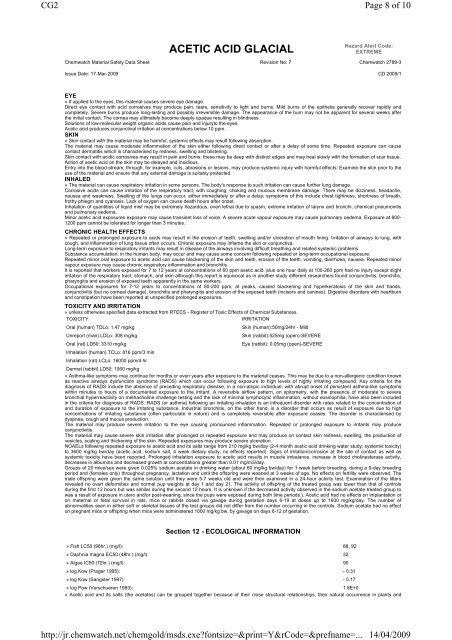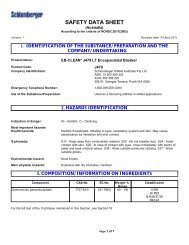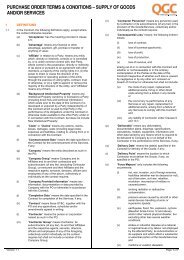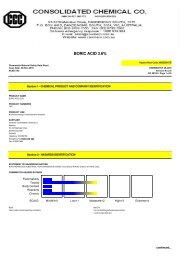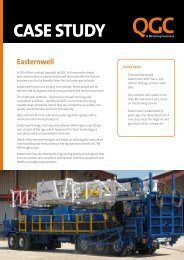Acetic Acid Glacial - QGC
Acetic Acid Glacial - QGC
Acetic Acid Glacial - QGC
- No tags were found...
Create successful ePaper yourself
Turn your PDF publications into a flip-book with our unique Google optimized e-Paper software.
CG2Page 8 of 10ACETIC ACID GLACIALHazard Alert Code:EXTREMEChemwatch Material Safety Data Sheet Revision No: 7 Chemwatch 2789-3Issue Date: 17-Mar-2009 CD 2009/1EYE» If applied to the eyes, this material causes severe eye damage.Direct eye contact with acid corrosives may produce pain, tears, sensitivity to light and burns. Mild burns of the epithelia generally recover rapidly andcompletely. Severe burns produce long-lasting and possibly irreversible damage. The appearance of the burn may not be apparent for several weeks afterthe initial contact. The cornea may ultimately become deeply opaque resulting in blindness.Solutions of low-molecular weight organic acids cause pain and injuryto the eyes.<strong>Acetic</strong> acid produces conjunctival irritation at concentrations below 10 ppm.SKIN» Skin contact with the material may be harmful; systemic effects may result following absorption.The material may cause moderate inflammation of the skin either following direct contact or after a delay of some time. Repeated exposure can causecontact dermatitis which is characterised by redness, swelling and blistering.Skin contact with acidic corrosives may result in pain and burns; these may be deep with distinct edges and may heal slowly with the formation of scar tissue.Action of acetic acid on the skin may be delayed and insidious.Entry into the blood-stream, through, for example, cuts, abrasions or lesions, may produce systemic injury with harmful effects. Examine the skin prior to theuse of the material and ensure that any external damage is suitably protected.INHALED» The material can cause respiratory irritation in some persons. The body's response to such irritation can cause further lung damage.Corrosive acids can cause irritation of the respiratory tract, with coughing, choking and mucous membrane damage. There may be dizziness, headache,nausea and weakness. Swelling of the lungs can occur, either immediately or after a delay; symptoms of this include chest tightness, shortness of breath,frothy phlegm and cyanosis. Lack of oxygen can cause death hours after onset.Inhalation of quantities of liquid mist may be extremely hazardous, even lethal due to spasm, extreme irritation of larynx and bronchi, chemical pneumonitisand pulmonary oedema.Minor acetic acid exposures exposure may cause transient loss of voice. A severe acute vapour exposure may cause pulmonary oedema. Exposure at 800-1200 ppm cannot be tolerated for longer than 3 minutes.CHRONIC HEALTH EFFECTS» Repeated or prolonged exposure to acids may result in the erosion of teeth, swelling and/or ulceration of mouth lining. Irritation of airways to lung, withcough, and inflammation of lung tissue often occurs. Chronic exposure may inflame the skin or conjunctiva.Long-term exposure to respiratory irritants may result in disease of the airways involving difficult breathing and related systemic problems.Substance accumulation, in the human body, may occur and may cause some concern following repeated or long-term occupational exposure.Repeated minor oral exposure to acetic acid can cause blackening of the skin and teeth, erosion of the teeth, vomiting, diarrhoea, nausea. Repeated minorvapour exposure may cause chronic respiratory inflammation and bronchitis.It is reported that workers exposed for 7 to 12 years at concentrations of 60 ppm acetic acid, plus one hour daily at 100-260 ppm had no injury except slightirritation of the respiratory tract, stomach, and skin although this report is equivocal as in another study different researchers found conjunctivitis, bronchitis,pharyngitis and erosion of exposed teeth apparently in the same workers.Occupational exposures for 7-12 years to concentrations of 80-200 ppm, at peaks, caused blackening and hyperkeratosis of the skin and hands,conjunctivitis (but no corneal damage), bronchitis and pharyngitis and erosion of the exposed teeth (incisors and canines). Digestive disorders with heartburnand constipation have been reported at unspecified prolonged exposures.TOXICITY AND IRRITATION» unless otherwise specified data extracted from RTECS - Register of Toxic Effects of Chemical Substances.TOXICITYIRRITATIONOral (human) TDLo: 1.47 mg/kgUnreport (man) LDLo: 308 mg/kgOral (rat) LD50: 3310 mg/kgSkin (human):50mg/24hr - MildSkin (rabbit):525mg (open)-SEVEREEye (rabbit): 0.05mg (open)-SEVEREInhalation (human) TCLo: 816 ppm/3 minInhalation (rat) LCLo: 16000 ppm/4 hrDermal (rabbit) LD50: 1060 mg/kg» Asthma-like symptoms may continue for months or even years after exposure to the material ceases. This may be due to a non-allergenic condition knownas reactive airways dysfunction syndrome (RADS) which can occur following exposure to high levels of highly irritating compound. Key criteria for thediagnosis of RADS include the absence of preceding respiratory disease, in a non-atopic individual, with abrupt onset of persistent asthma-like symptomswithin minutes to hours of a documented exposure to the irritant. A reversible airflow pattern, on spirometry, with the presence of moderate to severebronchial hyperreactivity on methacholine challenge testing and the lack of minimal lymphocytic inflammation, without eosinophilia, have also been includedin the criteria for diagnosis of RADS. RADS (or asthma) following an irritating inhalation is an infrequent disorder with rates related to the concentration ofand duration of exposure to the irritating substance. Industrial bronchitis, on the other hand, is a disorder that occurs as result of exposure due to highconcentrations of irritating substance (often particulate in nature) and is completely reversible after exposure ceases. The disorder is characterised bydyspnea, cough and mucus production.The material may produce severe irritation to the eye causing pronounced inflammation. Repeated or prolonged exposure to irritants may produceconjunctivitis.The material may cause severe skin irritation after prolonged or repeated exposure and may produce on contact skin redness, swelling, the production ofvesicles, scaling and thickening of the skin. Repeated exposures may produce severe ulceration.NOAELs following repeated exposure to acetic acid and its salts range from 210 mg/kg bw/day (2-4 month acetic acid drinking water study; systemic toxicity)to 3600 mg/kg bw/day (acetic acid, sodium salt, 4 week dietary study; no effects reported). Signs of irritation/corrosion at the site of contact as well assystemic toxicity have been reported. Prolonged inhalation exposure to acetic acid results in muscle imbalance, increase in blood cholinesterase activity,decreases in albumins and decreased growth at concentrations greater than 0.01 mg/m3/day.Groups of 20 mice/sex were given 0.025% sodium acetate in drinking water (about 60 mg/kg bw/day) for 1 week before breeding, during a 9-day breedingperiod and (females only) throughout pregnancy, lactation and until the offspring were weaned at 3 weeks of age. No effects on fertility were observed. Themale offspring were given the same solution until they were 5-7 weeks old and were then examined in a 24-hour activity test. Examination of the littersrevealed no overt deformities and normal pup weights at day 1 and day 21. The activity of offspring of the treated group was lower than that of controlsduring the first 12 hours but was similar during the second 12 hours. It is unknown if the decreased activity observed in the sodium acetate treated group towas a result of exposure in utero and/or post-weaning, since the pups were exposed during both time periods.). <strong>Acetic</strong> acid had no effects on implantation oron maternal or fetal survival in rats, mice or rabbits dosed via gavage during gestation days 6-19 at doses up to 1600 mg/kg/day. The number ofabnormalities seen in either soft or skeletal tissues of the test groups did not differ from the number occurring in the controls. Sodium acetate had no effecton pregnant mice or offspring when mice were administered 1000 mg/kg bw, by gavage on days 8-12 of gestation.Section 12 - ECOLOGICAL INFORMATION» Fish LC50 (96hr.) (mg/l): 88, 92» Daphnia magna EC50 (48hr.) (mg/l): 32» Algae IC50 (72hr.) (mg/l): 90» log Kow (Prager 1995): - 0.31» log Kow (Sangster 1997): - 0.17» log Pow (Verschueren 1983): 1.8E+0» <strong>Acetic</strong> acid and its salts (the acetates) can be grouped together because of their close structural relationships, their natural occurrence in plants andhttp://jr.chemwatch.net/chemgold/msds.exe?fontsize=&print=Y&rCode=&prefname=...14/04/2009


